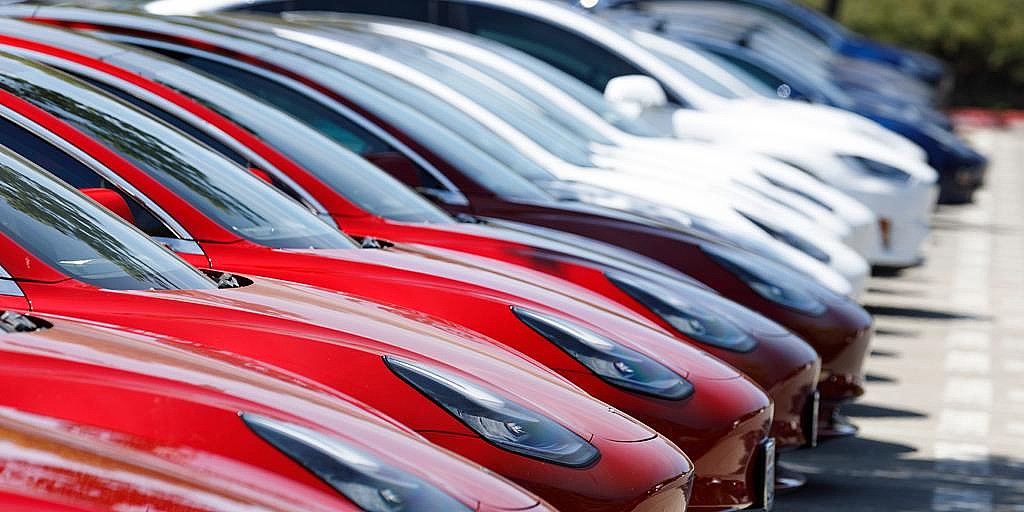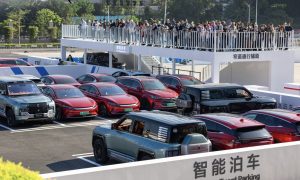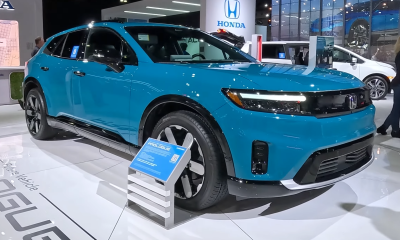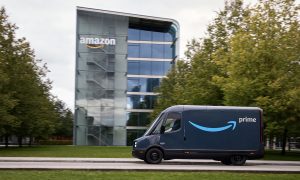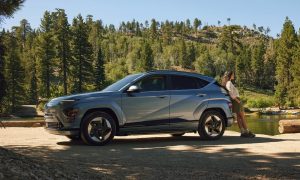The Biden Administration is pulling back on a proposed rule that would require automakers to build fewer combustion engine vehicles or face hefty fines.
On Tuesday, the Department of Energy decided to slow down the phase-out of existing rules that give car companies extra fuel-economy credits for the EVs they sell. The goal was to help U.S. car companies meet federal fuel efficiency standards while maintaining the ability to sell gas-powered pickups and SUVs that are big money makers.
The Biden White House decided to pull back the rules after meeting with automakers who said they could not meet the aggressive goals for a widespread EV transition.
The previous rules aimed to have 67 percent, or roughly two-thirds, of all new cars be electric by 2032. The new rules now allow for 30 to 56 percent of all new car sales to be EVs.
BREAKING
You might not own an electric vehicle by 2032, after all.
The EPA is *easing* its emissions rule ramp-up after major concerns from the car industry.
Percentage of EVs by 2032:
Previous plan: 67%
Current plan: 30-56%Dealers and consumers – how do you feel about…
— Car Dealership Guy (@GuyDealership) March 20, 2024
Last year, the U.S. EV market share was under 8 percent.
Tesla wants the U.S. to enact stricter fuel efficiency standards
The backpedaling comes as President Biden is attempting to bolster his re-election campaign. Reuters, in its report, points out that the move could be an attempt to sway some votes in his direction as the battleground state of Michigan, where General Motors and Ford, two legacy automakers, are based.
The Biden Administration’s concession comes as Donald Trump has stated that the heavy EV policies could cost millions of jobs and help Chinese EV makers dominate the growing U.S. EV sector.
The now-pulled-back proposal would have lowered “petroleum-equivalent fuel economy” ratings for EVs by 72 percent in 2027. By 2030, they would have been reduced by a total of 65 percent, giving companies more time to adjust to the strict standards.
Companies supported the announcement after they disclosed to the White House that meeting these standards would become increasingly difficult.
The Reuters report also states that GM would have faced $6.5 billion in fines, Stellantis would have been stuck with a $3 billion penalty, and Ford would have had $1 billion in fines.
The EPA also announced on Wednesday that it would implement revised standards for vehicle emissions from 2027 to 2032.
These new rules will require emissions reductions in every new car sold starting in 2027. To meet the new standards, automakers will be able to utilize cleaner technologies for gas-powered cars and add more zero-emissions EVs to their lineups.
The final rule would help the industry meet the limits of 56 percent of new vehicle sales being all-electric by 2032. It would also see at least 13 percent of new car sales be hybrid vehicles.
“Let me be clear: Our final rule delivers the same, if not more, pollution reduction than we set out in our proposal,” the EPA’s Michael Regan said, according to NBC.
“Today’s announcement will shift the trajectory of the automobile market and put us on a path to real emissions reductions, with an estimated 7.2 billion tons of global warming pollution avoided by 2055,” Steven Higashide, Director of the Clean Transportation Program at the Union of Concerned Scientists, said. “These rules are the strongest standards ever finalized and vital for meeting U.S. climate goals. This rule is technology-neutral and won’t mandate electric vehicles, but it will encourage this growing market. New cars sold in the coming years will be on the road for a decade or more, so it’s vital that these rules cut emissions from gasoline cars as well as encourage zero-emission electric cars.”
The new regulations are more aligned with the automotive industry’s beliefs. Dealers and the UAW saw previous plans from the EPA as unrealistic.
However, climate groups believe these standards will help eliminate emissions.
“These standards will help clean up emissions from transportation—the biggest source of global warming pollution in the U.S. To achieve their full potential, these rules must be accompanied by other investments in a cleaner, more accessible transportation system,” Higashide added.
I’d love to hear from you! If you have any comments, concerns, or questions, please email me at joey@teslarati.com. You can also reach me on Twitter @KlenderJoey, or if you have news tips, you can email us at tips@teslarati.com.
News
Tesla Robotaxi has already surpassed Waymo in this key metric
Tesla Robotaxi has already overtaken Waymo in Austin in one key metric, but there’s still more work to do.

Tesla Robotaxi has already surpassed Waymo in one extremely important key metric: size of service area.
Tesla just expanded its service area in Austin on Monday morning, pushing the boundaries of its Robotaxi fleet in an interesting fashion with new capabilities to the north. Yes, we know what it looks like:
🚨 Tesla’s new Robotaxi geofence is…
Finish the sentence 🥸 pic.twitter.com/3bjhMqsRm5
— TESLARATI (@Teslarati) July 14, 2025
The expansion doubled Tesla Robotaxi’s potential travel locations, which now include the University of Texas at Austin, a school with over 53,000 students.
The doubling of the service area by Tesla has already made its travel area larger than Waymo’s, which launched driverless rides in October 2024. It became available to the public in March 2025.
According to Grok, the AI agent on X, Tesla Robotaxi’s current service area spans 42 square miles, which is five square miles larger than Waymo’s service area of 37 square miles.
Tesla Robotaxi (red) vs. Waymo geofence in Austin.
Much can be said about the shape… but the Robotaxi area is now ~3.9 mi² (10 km²) larger than Waymo’s!! pic.twitter.com/dVfh2ODxJC
— Robin (@xdNiBoR) July 14, 2025
The service area is one of the most important metrics in determining how much progress a self-driving ride-hailing service is making. Safety is the priority of any company operating a ride-hailing network, especially ones that are making it a point to use autonomy to deploy it.
However, these companies are essentially racing for a larger piece of the city or cities they are in. Waymo has expanded to several different regions around the United States, including Arizona and Los Angeles.
Tesla is attempting to do the same in the coming months as it has already filed paperwork in both California and Arizona to deploy its Robotaxi fleet in states across the U.S.
As the platform continues to show more prowess and accuracy in its operation, Tesla will begin to expand to new areas, eventually aiming for a global rollout of its self-driving service.
News
Tesla Megapacks arrive for massive battery replacing coal plant
Tesla Megapacks have started arriving on-site to the Stanwell Battery Project, just as Queensland prepares to wind down the Stanwell coal plant.

The first of over 300 Tesla Megapacks have arrived to the site of a massive battery energy storage system (BESS) being built in Australia, dubbed the Stanwell Battery Project after a coal plant it’s set to replace.
In a press release last week, the Stanwell Battery Project announced that the first Tesla Megapack 2XL units had arrived to the site, which is located outside of Rockhampton in Queensland, Australia. The project will eventually feature 324 Megapack units, set to arrive in the coming months, in order to support the 300MW/1,200MWh battery project.
“The Stanwell Battery is part of the diversification of our portfolio, to include cleaner and more flexible energy solutions,” said Angie Zahra, Stanwell Central Generation General Manager. “It is just one part of the 800 MW of battery energy storage capacity we have in our pipeline.
“Capable of discharging 300 MW of energy for up to four hours (1,200 MWh), our mega battery will be one of the largest in Queensland.”

Credit: Stanwell
Did you know Tesla’s Lathrop facility churns out a Megapack every 68 minutes? That’s enough energy to power 3,600 homes for an hour per unit! ⚡️ pic.twitter.com/bG6fpHkB9O
— TESLARATI (@Teslarati) June 11, 2025
READ MORE ON TESLA MEGAPACKS: Tesla Lathrop Megafactory celebrates massive Megapack battery milestone
The state is working with government-owned company Yurika to facilitate construction, and the process is expected to create roughly 80 jobs. The project is expected to come fully online in May 2027, with initial commissioning of the Megapacks aiming for November 2025.
The Stanwell Battery is set to replace the nearby Stanwell coal generation plant, which the government is planning to wind down starting in 2026 as part of efforts to reach an 80 percent renewable energy generation ratio by 2035. Meanwhile, the government is also set to begin winding down the Tarong and Callide coal plants, while several other Megapack projects are being built or coming online. o ya
Tesla currently has two Megapack production facilities, located in Lathrop, California, in the U.S. and another that came online earlier this year in Shanghai, China. The Shanghai Megafactory shipped its first units to Australia in March, while both factories are expected to be capable of producing 10,000 Megapack units per year upon reaching volume production.
News
The Tesla Diner is basically finished—here’s what it looks like
The company first broke ground on the Diner, Drive-in, and Supercharger location in September 2023. Now, it has served one of its first internal customers.

Tesla has finally completed the construction of its highly anticipated Diner, Drive-in, and Supercharger in Los Angeles, and recent photos of the interior’s “retro-futuristic” style are making their way around the internet.
X user Brad Goldberg shared photos from the Tesla Diner site last Tuesday, depicting some of the Supercharger stalls, indoor and outdoor seating areas, multiple neon lights, and even an Optimus robot. Goldberg also noted that there had been a “flurry of activity on site” while he was snapping the photos last week, suggesting that the restaurant location could be getting close to opening.
The Tesla Diner also served one of its first internal customers in the past few days, as Elon Musk posted on X on early Monday morning that he had just finished up eating a meal at the site:
I just had dinner at the retro-futuristic Tesla diner and Supercharger.
Team did great work making it one of the coolest spots in LA!
The photos also show that the site is pretty much done, with some of them even showing vehicles charging at the charging stalls.
You can see some of the latest photos of the Tesla Diner below.

Credit: BradGoldbergMD | X

Credit: BradGoldbergMD | X

Credit: BradGoldbergMD | X

Credit: BradGoldbergMD | X

Credit: TeslaKing420 | X

Credit: TeslaKing420 | X

Credit: Brad Goldberg (via Sawyer Merritt on X)

Credit: Brad Goldberg (via Sawyer Merritt on X)

Credit: Brad Goldberg (via Sawyer Merritt on X)

Credit: Brad Goldberg (via Sawyer Merritt on X)

Credit: Brad Goldberg (via Sawyer Merritt on X)
READ MORE ON TESLA’S LA DINER: Tesla readies Drive-In Diner Supercharger for launch with app inclusion
When will the Tesla Diner open to external customers?
While it’s still not open to external customers yet, the news again suggests that the company could be close to an official opening date. Tesla first broke ground on the Diner in September 2023, after receiving a wave of building permit approvals throughout that year. Teslarati also covered much of the construction progress throughout last year, including when crews installed the first and second drive-in screens.
Located at 7001 West Santa Monica Boulevard, the idea was first discussed in 2018 by Musk and a few others on Twitter, featuring 1950s rock and roll, waiters on roller skates, and drive-in movie theater screens playing clips from some of history’s best movies. Notably, the photos of the front doors also show that the site will be open 24 hours a day, 7 days a week, whenever it does end up opening.
Tesla’s progress on Supercharger with diner, drive-in seen in aerial footage
-

 Elon Musk2 weeks ago
Elon Musk2 weeks agoTesla investors will be shocked by Jim Cramer’s latest assessment
-

 News2 days ago
News2 days agoTesla debuts hands-free Grok AI with update 2025.26: What you need to know
-

 Elon Musk4 days ago
Elon Musk4 days agoxAI launches Grok 4 with new $300/month SuperGrok Heavy subscription
-

 Elon Musk7 days ago
Elon Musk7 days agoElon Musk confirms Grok 4 launch on July 9 with livestream event
-

 News1 week ago
News1 week agoTesla Model 3 ranks as the safest new car in Europe for 2025, per Euro NCAP tests
-

 Elon Musk2 weeks ago
Elon Musk2 weeks agoxAI’s Memphis data center receives air permit despite community criticism
-

 News4 days ago
News4 days agoTesla begins Robotaxi certification push in Arizona: report
-

 Elon Musk2 weeks ago
Elon Musk2 weeks agoTesla scrambles after Musk sidekick exit, CEO takes over sales

